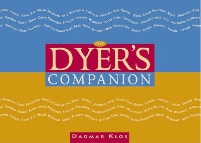a science fair project on artificial dyes versus natural dyes
Name: Kegan A.
Message: Hello I am doing a science fair project on artificial dyes vs. natural dyes. I need one source from a person. My question is : do you know of any natural dyes that are from plants easily obtained? Im looking for red blue and yellow. Thank you in advance.
The majority of natural dyes are inferior to the better types of synthetic dyes in almost every characteristic: they are more difficult to apply correctly, they usually produce duller colors, and they tend to wash out much more easily in the laundry. They are frequently neither safer or kinder to the environment, since they are often used with dangerous heavy metals as mordants, and some natural dyes are poisonous. However, it is fun to use natural dyes, knowing where they come from and about their history. The challenge of getting a good result with more difficult materials is satisfying to many experienced dyers. There are two mordants, alum and tannic acid, which are quite safe to use, with only a reasonable amount of care. If you find a reliable recipe, you can succeed with natural dyeing, though it is more difficult than dyeing with a fiber reactive dye such as Procion MX dye.
When you dye your test samples for your project, you will get the best results by dyeing wool or silk. Do not try to dye polyester or acrylic, unless your experiment involves comparing it to natural fibers. Cotton is more difficult to dye than wool, but can be dyed with the dyes I will now describe to you.

The only good blue natural dye is indigo, which is produced by some fifty different plants around the world, none of which will be easily obtained by you. Indigo is a natural vat dye and is far too difficult to use for someone who has never dyed anything before. The chemicals required must be used only under adult supervision. Most indigo available for sale is synthetic and thus not suitable for your thesis, though the synthetic indigo is molecularly identical to indigo obtained from plants such as woad, or from the plant that is called indigo. Indigo does not require the use of mordants, but it requires a dangerously high pH, produced by dissolving lye (sodium hydroxide or NAOH) in water, as well as some other chemicals which must be used only with competent adult supervision.

Yellow is a relatively easy color to find among natural dyes. The easiest for you to find, and use, would be turmeric, which is a spice used in cooking. You can easily find a jar of powdered turmeric root at the grocery store. Turmeric is a natural direct dye and can be used even on cotton with no mordant at all. Turmeric will work on any natural fiber. The biggest drawback with turmeric is that it fades over time. It is susceptible to damage by light. If you dye a garment yellow with turmeric, you will need to dye it again every year. Like all natural dyes, turmeric works best when applied in a cooking pot on the stovetop. Add your turmeric to water, simmer it for an hour ("simmering" is cooking at a temperature just below boiling), then strain it through a coffee filter to remove bits of powder, then add your fabric to the dye water and simmer it for half an hour or longer.
Red natural dyes are much harder to find than yellows, but much easier to work with than blues. You can mail-order cochineal from a natural dyes supplier such as Aurora Silk or Earth Hues. Both of these companies are listed, with contact information, on my page of Sources for Dyeing Supplies Around the World. Cochineal is a wonderful red dye that will work on any natural fiber. It is more expensive than similar synthetic dyes, but works very well. If you are going to use it on cotton, you must also use mordants, such as alum AND tannic acid; order your mordants from the same company you order your cochineal from. Cochineal is found in the food color carmine, which is widely used to color foods such as Yoplait strawberry yogurt, and cosmetics such as lipsticks; it is made from the dried bodies of small insects that infest a certain kind of cactus.

For more information about dyeing with natural dyes, see About Natural Dyes. I recommend that you get a good book on natural dyeing. You will need a good recipe for applying your mordants to your fabric, before you apply your dye, except of course for turmeric as indicated above. The book "The Dyer's Companion ", by Dagmar Klos, contains good recipes for mordanting. Our public library has it; check to see if yours does, too. Look for other good books on natural dyes that you can use as sources for your recipes and for use in your bibliography.
(Please help support this web site. Thank you.)
Message: Hello I am doing a science fair project on artificial dyes vs. natural dyes. I need one source from a person. My question is : do you know of any natural dyes that are from plants easily obtained? Im looking for red blue and yellow. Thank you in advance.
The majority of natural dyes are inferior to the better types of synthetic dyes in almost every characteristic: they are more difficult to apply correctly, they usually produce duller colors, and they tend to wash out much more easily in the laundry. They are frequently neither safer or kinder to the environment, since they are often used with dangerous heavy metals as mordants, and some natural dyes are poisonous. However, it is fun to use natural dyes, knowing where they come from and about their history. The challenge of getting a good result with more difficult materials is satisfying to many experienced dyers. There are two mordants, alum and tannic acid, which are quite safe to use, with only a reasonable amount of care. If you find a reliable recipe, you can succeed with natural dyeing, though it is more difficult than dyeing with a fiber reactive dye such as Procion MX dye.
When you dye your test samples for your project, you will get the best results by dyeing wool or silk. Do not try to dye polyester or acrylic, unless your experiment involves comparing it to natural fibers. Cotton is more difficult to dye than wool, but can be dyed with the dyes I will now describe to you.

The only good blue natural dye is indigo, which is produced by some fifty different plants around the world, none of which will be easily obtained by you. Indigo is a natural vat dye and is far too difficult to use for someone who has never dyed anything before. The chemicals required must be used only under adult supervision. Most indigo available for sale is synthetic and thus not suitable for your thesis, though the synthetic indigo is molecularly identical to indigo obtained from plants such as woad, or from the plant that is called indigo. Indigo does not require the use of mordants, but it requires a dangerously high pH, produced by dissolving lye (sodium hydroxide or NAOH) in water, as well as some other chemicals which must be used only with competent adult supervision.

Yellow is a relatively easy color to find among natural dyes. The easiest for you to find, and use, would be turmeric, which is a spice used in cooking. You can easily find a jar of powdered turmeric root at the grocery store. Turmeric is a natural direct dye and can be used even on cotton with no mordant at all. Turmeric will work on any natural fiber. The biggest drawback with turmeric is that it fades over time. It is susceptible to damage by light. If you dye a garment yellow with turmeric, you will need to dye it again every year. Like all natural dyes, turmeric works best when applied in a cooking pot on the stovetop. Add your turmeric to water, simmer it for an hour ("simmering" is cooking at a temperature just below boiling), then strain it through a coffee filter to remove bits of powder, then add your fabric to the dye water and simmer it for half an hour or longer.
Red natural dyes are much harder to find than yellows, but much easier to work with than blues. You can mail-order cochineal from a natural dyes supplier such as Aurora Silk or Earth Hues. Both of these companies are listed, with contact information, on my page of Sources for Dyeing Supplies Around the World. Cochineal is a wonderful red dye that will work on any natural fiber. It is more expensive than similar synthetic dyes, but works very well. If you are going to use it on cotton, you must also use mordants, such as alum AND tannic acid; order your mordants from the same company you order your cochineal from. Cochineal is found in the food color carmine, which is widely used to color foods such as Yoplait strawberry yogurt, and cosmetics such as lipsticks; it is made from the dried bodies of small insects that infest a certain kind of cactus.

For more information about dyeing with natural dyes, see About Natural Dyes. I recommend that you get a good book on natural dyeing. You will need a good recipe for applying your mordants to your fabric, before you apply your dye, except of course for turmeric as indicated above. The book "The Dyer's Companion ", by Dagmar Klos, contains good recipes for mordanting. Our public library has it; check to see if yours does, too. Look for other good books on natural dyes that you can use as sources for your recipes and for use in your bibliography.
(Please help support this web site. Thank you.)
Posted: Tuesday - November 13, 2007 at 09:23 AM
Follow this blog on twitter here.
Quick Links
- All About Dyes & Dyeing Top -
- Top of this blog -
- FAQ -
- The Dye Forum -
- How to Tie Dye - How to Batik -
- Books - Toys - Plants -
- Top of this blog -
- FAQ -
- The Dye Forum -
- How to Tie Dye - How to Batik -
- Books - Toys - Plants -
More in this category:
- -
Statistics
Total entries in this blog:
Total entries in this category:
Published On: Aug 29, 2012 02:48 PM
Total entries in this category:
Published On: Aug 29, 2012 02:48 PM